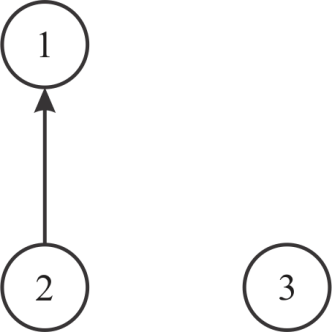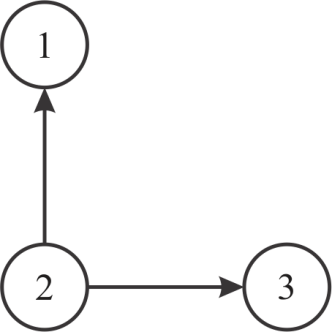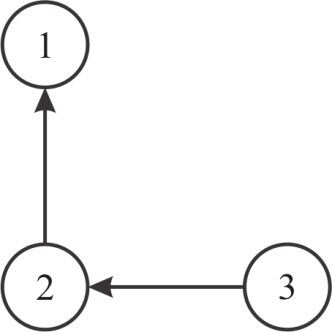a)
Suppose  be the
be the
 matrix
representing the transitive closure, in such way that
matrix
representing the transitive closure, in such way that  is 1 if
there exists a path from
is 1 if
there exists a path from  to
to , otherwise
0.
, otherwise
0.
• When a new edge is added into the graph, then check whether there is a possible path through the new edge. If there is a possible path, then update the matrix according to that.
• The algorithm must contain only two loops which iterate based
on the vertex V, because it must be .
.
Consider the algorithm of transitive closure which updates the transitive closure for each update into the graph.
TRANSITIVE-CLOSURE (u, v)
// iterate loop for all the vertices of graph
1. for
// iterate loop for another vertices of graph
2. do for
// if path from vertex p to u and v to q exists
3. do if
// updating new edge into the matrix
4. then
In this algorithm after adding an edge it may affect the whole matrix so this program updates each necessary index of matrix after adding an edge.
Since to traverse the whole matrix and checking whether to update the value or not, it requires two nested loops.
Since there are two ‘for’ loops iterating with
 ,
the complexity of the above algorithm is
,
the complexity of the above algorithm is  .
.
Consider the following procedure to update the transitive
closure  of a graph
of a graph
 when a new edge is added to
when a new edge is added to .
.
Consider a graph with no edges as shown below.

Initially there is no edge in the graph, so, the matrix will be
in the form of ,
if
,
if and otherwise 0.
and otherwise 0.

Now, add the edges to the graph and compute the transitive closure using TRANSITIVE-CLOSURE algorithm.
• Suppose, first edge connect the vertex 2 and 1, then for
 and
and , the
condition
, the
condition and
and
 becomes
true so,
becomes
true so,  and
and .
.
• So, , in this
case, which is
, in this
case, which is  becomes
one.
becomes
one.
Now, the new graph and corresponding matrix is given below:

So, , in this
case, which is
, in this
case, which is  becomes
one.
becomes
one.

If the next adding edge is , then the
two conditions become true. Now,
, then the
two conditions become true. Now,  becomes 1
since there is a path from 3 to 1.
becomes 1
since there is a path from 3 to 1.
New graph and its transitive closure are as shown below:

So, , in this
case, which is
, in this
case, which is  becomes
one.
becomes
one.

Similarly, the TRANSITIVE-CLOSURE algorithm can be repeated to update the transitive closure matrix A for any edge that is added into the graph.
b)
Consider a straight line graph having n vertices and algorithm TRANSITIVE-CLOSURE mentioned above (part a):

The transitive closure of the given graph will be as below:

• In the above matrix, it can be seen that before adding any new
edge, there are total  entries and
the transitive closure of the given graph is 1.
entries and
the transitive closure of the given graph is 1.
• The entries, which are above from the main diagonal contains 1 as a value.
Insert a new edge that connects the first and last vertex of the
graph  as shown
below:
as shown
below:

Then, the above graph will become a cyclic graph. Now, all the edges are reachable from every other edge.
Then all the  entries will
become 1.
entries will
become 1.
So,

Entries must be needed to update the transitive closure. Thus,
the time required to update the transitive closure is .
.
c)
If a graph has n vertices, then there are maximum
 edges or
edges or
 edges which can be added to the graph.
edges which can be added to the graph.
• For adding one edge, the algorithm TRANSITIVE-CLOSURE defined
in part (a) will take  time thus
to add
time thus
to add  edges, the
above mentioned algorithm will take
edges, the
above mentioned algorithm will take  time.
time.
• Above algorithm is inefficient if there is already a path from p to v or v to q.
Consider the graph as shown below along with its transitive closure:

The matrix for the above graph is as shown below:

Add the edge  to the
graph, there is no need to update the transitive closure because
there is already a path from 3 to 1 through the vertex 2. So, the
loop over q in above algorithm is redundant when
to the
graph, there is no need to update the transitive closure because
there is already a path from 3 to 1 through the vertex 2. So, the
loop over q in above algorithm is redundant when .
.
• Below algorithm gives the updated transitive closure matrix after inserting the new edges to the graph.
• For updating the matrix, logical “and” operator used. After this checking process, updates are performed accordingly.
TRANSITIVE-CLOSURE-UPDATE (u, v)
// iterate loop for all the vertices of graph
1. for
2. do if
// iterate loop for all the vertices of graph
3. then for
4. do if
5. then 
Explanation of the above algorithm:
It is known that there can’t be greater than  edges in the
graph
edges in the
graph , therefore,
, therefore,
 .
.
• Now, the addition of  insertions,
so total time taken in the first given two lines of the above
algorithm is
insertions,
so total time taken in the first given two lines of the above
algorithm is  or
or , because
, because

• In the line numbers 3, 4 and 5, which takes  time, for
n insertions are executed only
time, for
n insertions are executed only  times.
times.
• It can be easily seen that the execution of the last three
lines are performed only when , and in
this case, the line number 5, sets
, and in
this case, the line number 5, sets .
.
• So, the 0 entries’ number in  is reduced
minimum 1 every time when the last three lines of the code
run’s.
is reduced
minimum 1 every time when the last three lines of the code
run’s.
• Since, there exists only  entries
in
entries
in and these
lines can run maximum
and these
lines can run maximum  times.
times.
Hence, the above procedure takes  time
to update the transitive closure for any sequence of
n insertions.
time
to update the transitive closure for any sequence of
n insertions.
a.
The asymptotic running times for INSERT, EXTRACT-MIN and
DECRESAE-KEY, as a function of d and the number n of elements in a
d-ary min heap are  ,
,  and
and
 respectively.
The amortized costs for these operations in a Fibonacci heap are as
follows:
respectively.
The amortized costs for these operations in a Fibonacci heap are as
follows:  ,
,  ,
,  respectively.
respectively.
b.
The shortest paths can be computed from a single source on an
 -dense
directed graph
-dense
directed graph  with no
negative-weight edges in
with no
negative-weight edges in  time by
choosing
time by
choosing  .
.
Implement Dijkstra’s algorithm using d-ary min-heap.
Thus, the run time will be  for
constant
for
constant  ,
,  .
.
c.
The all-pairs shortest problem on an  -dense
directed graph
-dense
directed graph  with no
negative-weight edges can be solved in
with no
negative-weight edges can be solved in  time by
running the algorithm made by using Dijkstra’s algorithm. This
algorithm will run once for each vertex of the graph.
time by
running the algorithm made by using Dijkstra’s algorithm. This
algorithm will run once for each vertex of the graph.
d.
The all-pairs shortest-paths problem can be solved in  time on an
time on an
 -dense
directed graph
-dense
directed graph  that may
have negative weight edges but has no negative weight cycles by
creating the graph G that has all non-negative edge weights.
that may
have negative weight edges but has no negative weight cycles by
creating the graph G that has all non-negative edge weights.